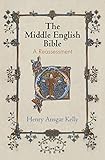The Middle English Bible : A Reassessment / Henry Ansgar Kelly.
Material type: TextSeries: The Middle Ages SeriesPublisher: Philadelphia : University of Pennsylvania Press, [2016]Copyright date: ©2017Description: 1 online resource (368 p.)Content type:
TextSeries: The Middle Ages SeriesPublisher: Philadelphia : University of Pennsylvania Press, [2016]Copyright date: ©2017Description: 1 online resource (368 p.)Content type: - 9780812248340
- 9780812293081
- 220.6 23
- BS511.3
- online - DeGruyter
| Item type | Current library | Call number | URL | Status | Notes | Barcode | |
|---|---|---|---|---|---|---|---|
 eBook
eBook
|
Biblioteca "Angelicum" Pont. Univ. S.Tommaso d'Aquino Nuvola online | online - DeGruyter (Browse shelf(Opens below)) | Online access | Not for loan (Accesso limitato) | Accesso per gli utenti autorizzati / Access for authorized users | (dgr)9780812293081 |
Browsing Biblioteca "Angelicum" Pont. Univ. S.Tommaso d'Aquino shelves, Shelving location: Nuvola online Close shelf browser (Hides shelf browser)

|

|

|

|

|

|

|
||
| online - DeGruyter Pious Irreverence : Confronting God in Rabbinic Judaism / | online - DeGruyter Intimate Bonds : Family and Slavery in the French Atlantic / | online - DeGruyter Messengers of the Right : Conservative Media and the Transformation of American Politics / | online - DeGruyter The Middle English Bible : A Reassessment / | online - DeGruyter Slavery's Capitalism : A New History of American Economic Development / | online - DeGruyter Korea's Grievous War / | online - DeGruyter Front Lines : Soldiers' Writing in the Early Modern Hispanic World / |
Frontmatter -- Contents -- Preface -- Abbreviations -- Chapter 1. A History of Judgments on the Middle English Bible -- Chapter 2. Five and Twenty Books as ‘‘Official’’ Prologue, or Not -- Chapter 3. The Bible at Oxford -- Chapter 4. Oxford Doctors, Archbishop Arundel, and Dives and Pauper on the Advisability of Scripture in English -- Chapter 5. The Provincial Constitutions of 1407 -- Chapter 6. Treatment of the English Bible in the Fifteenth Century -- Chapter 7. The End of the Story: Richard Hunne and Thomas More -- Conclusion -- Appendices -- Notes -- Works Cited -- Index
restricted access online access with authorization star
http://purl.org/coar/access_right/c_16ec
In the last quarter of the fourteenth century, the complete Old and New Testaments were translated from Latin into English, first very literally, and then revised into a more fluent, less Latinate style. This outstanding achievement, the Middle English Bible, is known by most modern scholars as the "Wycliffite" or "Lollard" Bible, attributing it to followers of the heretic John Wyclif. Prevailing scholarly opinion also holds that this Bible was condemned and banned by the archbishop of Canterbury, Thomas Arundel, at the Council of Oxford in 1407, even though it continued to be copied at a great rate. Indeed, Henry Ansgar Kelly notes, it was the most popular work in English of the Middle Ages and was frequently consulted for help in understanding Scripture readings at Sunday Mass.In The Middle English Bible: A Reassessment, Kelly finds the bases for the Wycliffite origins of the Middle English Bible to be mostly illusory. While there were attempts by the Lollard movement to appropriate or coopt it after the fact, the translation project, which appears to have originated at the University of Oxford, was wholly orthodox. Further, the 1407 Council did not ban translations but instead mandated that they be approved by a local bishop. It was only in the early sixteenth century, in the years before the Reformation, that English translations of the Bible would be banned.
Mode of access: Internet via World Wide Web.
In English.
Description based on online resource; title from PDF title page (publisher's Web site, viewed 04. Okt 2022)


